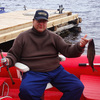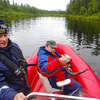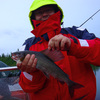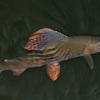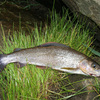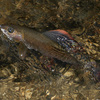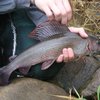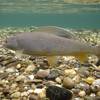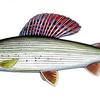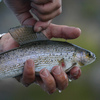Grayling fishing
Grayling in northern rivers. The grayling avoids still water and prefers remaining in the rapids. This fish like to stay in rapids and stretches of the river, adjacent to overflows. However, the grayling does not go into the strait and remains at the tail end of the channel or on the edges, at the outer limits of the straight and reverse flows. It can often be seen waiting behind large above water and drowned rocks, at the merging point of two jets. Large size grayling likes to hide behind logjams, among sunken logs, marine growth, hides under steep banks, which have meadow grass cover or bushes hanging over the water.
After finding a suitable spot the fattening grayling can whole summer in the same place, moving around only within a limited area of its prey. This fish only migrates, when the temperatures go high and the water starts to get more than warm. In this period the grayling leaves its abode and goes for the sources of cold water and you can see hoards of grayling there. In wider lakes you should look for grayling near rocky shores, where the depth is no more than 2m, as well as near the boulder shores, where the fish comes for the abundance of gammarus and caddis.
In open waters the grayling can be fished from the time of finishing spawning and till the end of autumn, using various methods and tackle. The hungry grayling very actively bites after spawning. In this period it can be fished using (often in very translucent waters) worm, bark beetle larvae, young fish or even the meat of grayling itself. It is better to use medium size hooks, connecting it to light inertia-free spool. Following is the ordinary tackle: main line of diameter 0.25mm; gangling 0.15-0.17mm (0.4-0.6m length); lead weight – 2-3 pellets, tied 20-30 cm from the hook; hook № 5-7 (as per Russian numbering). You can fish with float or without it (in rapid waters). Throwing the line, you must keep it tight at all time, to be able to quickly draw in case of a bite – the grayling instantly chews the attachment.
In wider rivers this fish remains far from the banks, therefore, you often need to throw the line a long distance away. When fishing with a float, you can do this either by increasing the lead weight 10-15 g, or by using special float within built-in load of the same mass. However, in both cases the size of the float should be such that its antenna would remain significantly above water. The effectiveness of the use of leading rod without float can be increased, for example, by converting it into something like a migrating leger rig. For the purpose, you must connect a gangling of double the length to the main line, at a distance of 30-40c m from the hook and add a lead weight of round or oval form of weight 10-20g (the weight must be greater in faster currents). Such tackle can be used in rivers with more or less even bed. At the same time, with the line tightened with the end of the rod, the weight is raised, simultaneously releasing the line from the reel, so that it could shift with the current to some distance downstream. You need to repeat this action from time to time, making the lead weight and consequently the tackle to move in the water along a large radius.
As the water gets clearer in the rivers, the grayling starts preying on various insects and the fishermen have a good chance of fishing with a fly. Usually these baits are made similar to some insect (butterfly, crickets, gad-fly), but sometimes they made in shape of imaginary insects.
Often in texts about fishing, which talk about grayling fly fishing, you can see such terms as “surface” and “submerged” fly. In reality both these terms mean the use of a similar kind of fly – “wet”, however, during fishing their purposes are different. It is assumed that the “submerged” fly is the one which goes deeper into water, whereas the “surface” fly remains on the surface of water or goes little bit beneath the surface. To use the “wet” fly as “surface” fly, most often we coercively hold it with the rod, but we can achieve the same using the raising effect, created by fast current.
Which option is better, with “Surface” or “submerged” fly? Usually this question is decided on the basis of the specifics of the water body, time of year and day, weather conditions and other factors. Quite often you can decide on the basis of the fish’s behaviour during feeding. When the grayling surfaces to feed (specific bow waves and splash sounds) or awaits the food below the water (on the surface you see small whirlpools), it is logical to use “surface” fly. This technique is most suitable for fishing in the rapids in June-July at mid-day or afternoon. By the end of summer of in Fall the grayling better bites “submerged” fly, and windy weather proves to be helpful for fishing.
In the summer the grayling has no need for food. Therefore it is difficult to attract it using artificial feed. The amount of catch depends on the proper selection of flies as per size and shades. The best way of knowing this is to open the hooked grayling’s belly and see what type of flies it best bites on. At certain times even larger fish can bite on very small flies, ignoring larger insects.
The grayling can very finely distinguish between the colours and shades of the bait. But its colour identification capability depends on the available light in the water and its transparency levels. In more translucent waters you should use more contrasting baits. In fact the grayling does not like bright colours and is best baited in cloudy conditions and when fishing on sunny days, it is better to opt for afternoon and later. Most often people use flies with brown, red, dark-grey and mulatto belly shades. The grayling is very fond of the red colour, so it is recommended to start fishing in unknown waters with a red bait.
The grayling can be angled in many ways using the fly. The most popular method is flyfishing. The classical flyfishing technique is not very popular in Russia yet. Most of the fishermen in Russia use the so-called “usual” flyfishing technique. For the purpose they use ordinary swing rod of 7-10 m length, with a 0.20-0.25 mm line. It is convenient to use a single fly, but many fishermen use a double fly. When surface fishing with bait, they do not let it submerge after contacting the water, permanently drawing and throwing it again. Sometimes, when there is ample catch, when the river is filled surfacing of the fish, the grayling jumps out of water attempting to bite the fly, before it touches the surface. But often the situation is contrary to this one. Biting on above surface mosquitoes, the fish shows no interest in the “surface” fly and now tips and tricks can lure it to bite. However, strange as it maybe, the “key” to fishing grayling in such conditions, lies in removing the “surface” fly and replacing it with “submerged” fly. This is how it is done. Letting the fly submerge (not very deep), the fishermen then make solid movements with the rod to move the fly sideways. The effect can be just phenomenal – the fish starts biting right away. Most probably such actions invoke hunting instincts in the fish, which makes it bite the fly instinctively – hold the fly before it escapes…
There is another very common method of fishing with the fly – using leading tackle, comprising of spinning and float-weight (semi-flyfishing), for example using sbirulino or bombarda. The specific of such tackle is that the float (commonly of 10-20g), is not used as an indicator of bite, but to help throw the line far and to an exact location. The rod must be of class II or III, the reel – with 60-80m of line. There are various structures of the floats used. Among some of the fishermen the hollow sphere of transparent plastic is very common. It weight can be altered as required, changing the amount of water filled in it. However, currently the most common types are cone shaped floats of lengths 12-15 cm. they are made of hard polystyrene and are fitted at bottom with lead weight (the wider end). The following option of tackle is the most common. The float is attached to the end of 0.25-0.30 mm thick line and above it (at various distances from each other) you attach 2-3 flies on a short stretch of line. In a more complete variant the tackle has an extra stretch with fly (length no more than 0.5m), which is attached to the float’s bottom through the swivel.
Above the fly, on this stretch of line, you normally add a number of pallets, with diameters increasing as the distance from the bait increases.
When fishing from the bank the line is thrown across or against the current. After this the tackle is raised at an angle of 60-80O, to make the flies in front of the float act as “surface” flies. To make it more interesting, the line, while releasing or rolling back, can be slightly jerked. If it turns out that the grayling bites better in deep water, the fly I front of the float can be turned into “submerged” one, dragging the rod inline with the line.
It is also common to fish for grayling with “torpedo” (“vessel”). Previously the fishermen used single level vessels, made of plaques burdened on one side. Currently the most common are the two-level, “catamaran” type vessels. The advantage of using the latter is that they are easily manageable and very stable in waves.
It is recommended to use hard spinning with inertial spinning, to better control the “torpedo”. Fishermen normally use 0.35-0.40 mm thick line as main one. When fishing with many flies, instead of just one, the sizes must be selected in such a way as to make sure that during “jerking” the baits would touch the water simultaneously. To make the tackle more versatile some fishermen attach the stretches in such a way as to be able to remove them quickly. For the purpose the stretches are attached to the main line through the swivel, which moves freely over the main line between the two delimiters.
The fish might bite when the “torpedo” is against the current, or downstream. Normally the grayling points itself out (it often happens, when using treble hooks). The taking of bait is, usually, felt in hands. Apart from that the hooked fish “tells” of its presence causing the particular local bend in the main line.
You can use the “torpedo” to fish in the lake as well. Throwing the tackle from the shore at the required distance, it should be pulled along the shoreline in such a way to keep the fly afloat.
It is very interesting to fish the grayling using the “jerk” technique. Two fishermen join their spinning into one and attach 2-3 flies to it (approximately 1 meter stretches). They fish from opposite banks of the river. Holding the line under tension (with little bit of bend), they “jerk” the flies on the water, in an attempt to attract the fish to take the bait. In case of bite, both the fishermen strike. One of them draws (as decided earlier), while the other releases the line. This technique is effective if the partners have harmony in their actions.
If the grayling does not attract to the fly, you can replace it with the lure. The fish better take this bait in the end of summer and in autumn. It is noted that the grayling is not very stable towards the blinker: it often swims along the lure, but seems hesitant in biting on it. The “petal” type rotating lures are a lot more effective. The optimum petal length for grayling lures is 15-30mm. the “Mepps” lures, such as “Aglia” and “Elix” (№ 0-3) are very popular among the fishermen. Some of the smaller lures by “Rodex” and “Salmo” are also very much appreciated. The value of catch significantly increasing, when you use the lure-fly.
The grayling’s bite on the lure is similar to that of the pike, but as soon as it takes the bait it starts “running” from side to side, makes abrupt dashes, jumps out of the water and tumbles. The grayling has soft lips, so it is important to carefully draw the fish out, making sure not to hasten the process, especially if the fish took the bait against the current.
